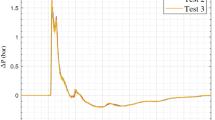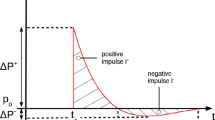Abstract
In this study, the complex phenomena of propagation and interaction of the blast waves impacting on obstacles were visualized and investigated using a numerical method. Three different distances between an immovable wall and a bomb shelter with a square block inside were considered while a blast source is located in front of wall at the same distance from shelter. The transitional shock phenomena were simulated by means of a multi-block mesh system and a flux computational model. Spatial discretization was performed using the Roe’s upwind schemes; time integration was achieved via the second-order explicit Hancock method. Proof of the numerical results indicated that those results were in close agreement with the experimental data obtained for the wedge flow. For the cases proved, the geometries of the reflected wave patterns followed by the incident blast waves crossing the immovable wall and impacting inside of bomb shelters were similar. However the height of wall has a dominating impact on the effect associated with different incident blast waves from the same blast source. Meanwhile, different reflected overpressure-time histories and streamlines were observed and analyzed for the results obtained.
Similar content being viewed by others
References
Ben-Dor, G., Shock wave reflections phenomena, (1991), 1–73, Springer-Verlag, New York, N.Y.
Cattafesta III, L. N. and Settles, G. S., Experiments on shock/vortex interactions, AIAA-92–0315, (1992).
Fluent co., Using the solver, Fluent User’s Guide 6.1, 1 (2003).
Heilig, W., Use of the shock tube for generating blast wave, Proceedings of the 16th International Symposium on Military Aspects of Blast and Shock, Cranfield University, (Oxford, UK), (2001).
Igra, O., Wu, X., Hu, G. Q. and Falcovitz, J., Shock wave propagation into a dust-gas suspension inside a double-bend conduit, J. of Fluid Engineering, 124 (2002), 483–491.
Malamud, G., Levi-Hevroni, D. and Levy, A., Two-dimensional model for simulating shock-wave interaction with rigid porous materials, AIAA J., 41-4 (2003), 663–673.
Murphy, M. J., Adrian, R. J, Stewart, D. S., Elliott, G. S., Thomas, K. A. and Kennedy, J. E., Visualization of blast waves created by exploding brige wires, Journal of Visualization, 8-2 (2005), 125–136.
Sun, L. Q., Sugiyama, H., Mizobata, K. and Fukuda, K., Numerical and Experimental Investigations on the Mach 2 Pseudo-Shock Wave in a Square Duct, Journal of Visualization, 6-4 (2003), 363–370.
Tai, C. H., Chiang, D. C. and Su, Y. P., Explicit Time Marching Method for the Time-Depent Euler Computations, Journal of Computational Physics, 130 (1997), 191–202.
Tai, C. H., Tneg, J. T., Lo, S. W. and Liu, C. W., A Three-Dimensional Numerical Investigation into the Interaction of Blast Waves with Bomb Shelters, JSME, Series B, 48-4 (2005), 820–829.
Takayama, K. and Jiang, Z., Shock wave reflection over wedges: A Benchmark test for CFD and Experiments, Shock Waves, 4 (1997), 191–203.
Thiagarajan, V., Panneerselvam, S. and Rathakrishnan, E., Numerical Flow Visualization of a Single Expansion Ramp Nozzle with Hypersonic External Flow, Journal of Visualization, 9-1 (2006), 91–100.
van Leer, B., Thomas, J. L., Roe, P. L. and Newsome, R. W., A Comparison of Numerical Flux Formulas for the Euler and Navier-Stokes Equations, AIAA Paper 87–1104-CP, (1987).
Viren, M., Jagadeesh, G., Reddy, K. P. J., Sun, M. and Takayama, K., Visualization of shock waves around hypersonic spiked blunt cones using electric discharge, Journal of Visualizatyion, 8-1 (2005), 65–72.
Yngve, G. D., O’Brien, J. F. and Hodgins, J. K., Animating explosions, Proceedings of SIGGRAPH 2000, (2000), 29–36.
Author information
Authors and Affiliations
Corresponding author
Additional information
Chang-hsien Tai: He has Bachelor’s and Master’s degrees in Mechanical Engineering, and Doctorate degrees in Aerospace Engineering in University of Michigan. He is a professor in the Department of Vehicle Engineering and the dean of College of Engineering at National Pingtung University of Science and Technology (NPUST). Prof. Tai experts in CFD,fluid dynamics and numerical analysis. In his capacity as supervising the Numerical Simulation Laboratory at National Defense University and NPUST, Prof. Tai has spearheaded with the applications to transient flow, subsonic compressible, hypersonic flow in weapon system. And he is author or co-author of more than 200 publications in journals and conferences.
Jyh-tong Teng: He is a Professor of Mechanical Engineering Department and Dean of College of Engineering at Chung Yuan Christian University. He received his B.S. M.E. from Montana State University, and his M.S. M.E. and Ph.D. M.E. from University of California, Berkeley. He holds the Professional Engineer License in M.E., issued by the State of California. His research areas include thermo-fluidic analyses of compartment fires and smoke, internal combustion engines, shock waves, nuclear safety (including loss-of-coolant accidents, severe accidents, and severe accident management and its guidelines), and electronic device/microchannel cooling.
Shi-wei Lo: He received his M.Sc. (Eng.) degree in Weapon System Engineering in 1998 from Chung Chang Institute of Technology and his Ph.D. in Mechanical Engineering in 2006 from Chung Yuan Christian University. After obtaining M. Sc., he worked as an instructor of vehicle at Chinese Army. He then became a military training officer of NPUST. His current research interests are computational fluid dynamics and vehicle design and application.
Hsien-Chin Chou: He received his M.S. M.E. from Polytechnic University in N.Y. USA, He is now an Engineer at Chung Shan lnstiture of Science and Technology and a graduate student for doctor’s degree at CYCU since 2000. He is conducting his graduate thesis research both with Prof. Teng and Prof. Tai. The focus of his research is to investigate the phenomena about blast wave, especially in the application of weapon system. His work also covers the study of numerical code, combustion mechanism, heat convection and turbulent flow.
Rights and permissions
About this article
Cite this article
Tai, C.H., Teng, J.T., Lo, S.W. et al. Two-dimensional numerical visualization on the interaction of blast waves with obstacles. J Vis 11, 87–94 (2008). https://doi.org/10.1007/BF03181918
Received:
Issue Date:
DOI: https://doi.org/10.1007/BF03181918




